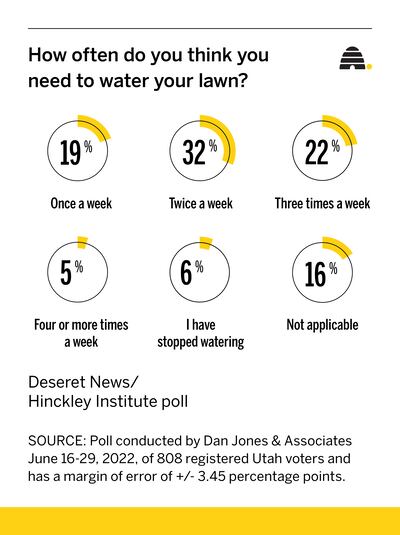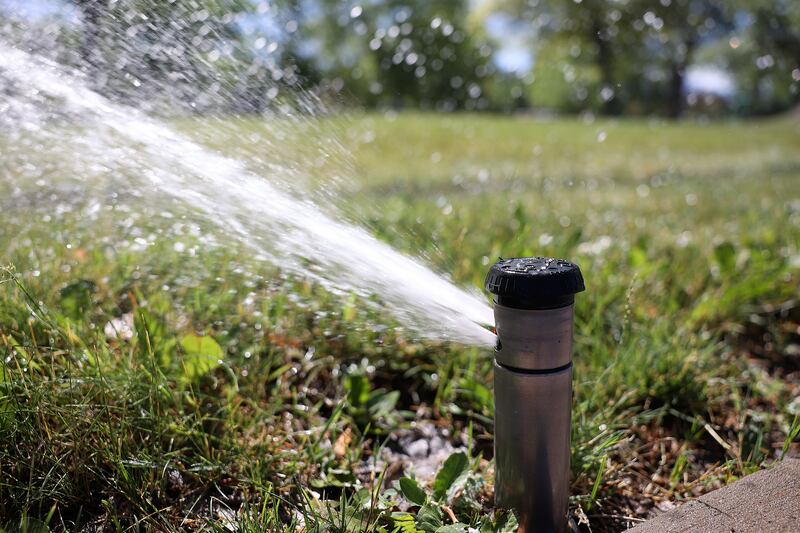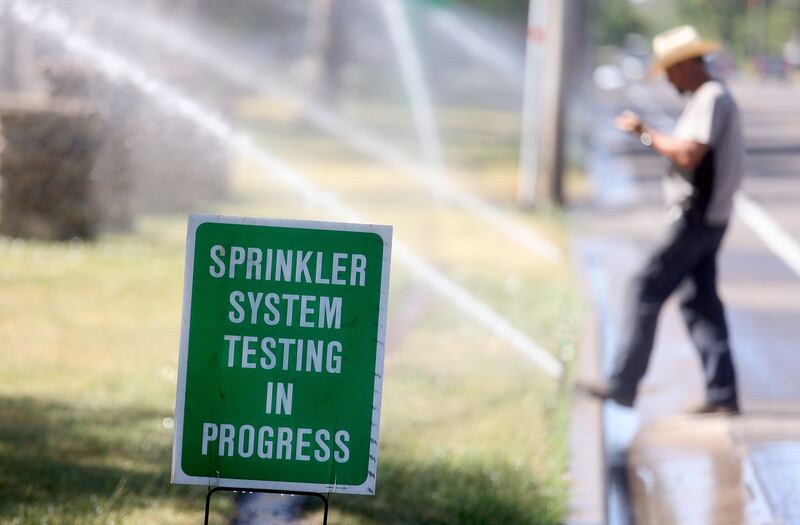A brown lawn has become a badge of honor in Utah as the state copes with a historic drought — even Gov. Spencer Cox tweeted pictures of the dying grass at his farm in Fairview last July.
And according to a new Deseret News/Hinckley Institute of Politics poll, it appears Utahns are following suit, or at least listening to Beehive State officials who are urging residents to conserve water.
At least 73% of respondents think their lawn needs to be watered three times a week or less — 19% said once a week, 32% said twice and 22% said three times.

The responses are more or less aligned with the Utah Division of Water Resources’ weekly lawn watering guide, which currently advises three irrigations for residents across the state.
That’s welcome news to Josh Zimmerman, water conservation coordinator with the division, who says the poll points to a growing shift in how Utahns use water.
“If we polled this even three years ago, I think it would have been different,” Zimmerman said. “The dry water years that we’ve had have put us in a situation where water is on everyone’s mind.”
About 5% of survey respondents say their lawn needs water four or more times a week, while 6% say they have stopped watering altogether.
An additional 17% answered “not applicable,” which Zimmerman said likely consists of people living in apartments and high-density housing, or renters.
Dan Jones & Associates conducted the poll of 808 registered Utah voters from June 16-29. It has a margin of error of plus or minus 3.45 percentage points.
John Oliver, host of HBO’s “Last Week Tonight with John Oliver,” recently ripped Utah for using the most water of any state in the West, mocking St. George’s golf courses and Cox’s call for prayers for rain last year, which Oliver called “the worst idea (the state has) had.”
Cox responded in a tweet that Oliver failed to “research/report most of the work that has been done on these issues … so I thought it might be helpful to put as much of it as possible in an easy thread for anyone that is really interested” before listing a handful of things Utah has done in the past year to address the drought.
If you’re looking to conserve water, the lawn is the best place to start. Irrigation is by far the biggest source of residential water use. About 2,000 to 3,000 gallons of water goes into a daily irrigation cycle for the average Utah lawn, according to the Division of Water Resources.
Toilets are the second largest use of water, but it’s not even close to turf — if you cut back on roughly 10 flushes a day, you’ll save between 20 to 70 gallons.
Zimmerman has advice for anyone looking to conserve water. First, he said, prioritize what and where you water — trees and shrubs should be irrigated before turf.

“Established trees will make it through a situation like this. But if they’re stressed, it is important to hit those trees with some extra water because they provide important shade and cooling,” he said.
Second, adjust your sprinklers, and make sure water is actually hitting the grass, and not inadvertently the sidewalk or street. That could even mean giving your neighbors a friendly nudge if you see water from their sprinklers pooling on the concrete.
And lastly, Zimmerman said, test your sprinkler system. Irrigation schedules are based on how long it takes to apply a half inch of water to a lawn. There are several ways to test your system, including an at home test, or signing up for Utah State University’s Water Check Program.
“If you don’t know how fast the water is coming out of your sprinklers and hitting your lawn, it’s very hard to be efficient,” he said.
And it turns out, many Utahns are using too much water when they irrigate their grass.
A recent study conducted by BYU civil and construction engineering professor Rob Sowby found that nearly half of Utahns are using too much water in an effort to keep their grass healthy.
“The gut reaction is, more water equals more green. But there’s a curve, there’s an optimal point. And as you put more water on, that’s all you’re doing, you’re not making it any healthier,” Sowby told the Deseret News in May.
Weeds like crabgrass or thatch, fungal growth like mushrooms and standing water or runoff after irrigation are all signs of overwatering. Ironically, so is yellowing and eventually dying patches, which sometimes lead homeowners to believe they aren’t watering enough.
“When your lawn starts to turn yellow or brown, that may be misinterpreted as underwatering. That’s where it gets tricky, because you may not know the difference,” Sowby said.


